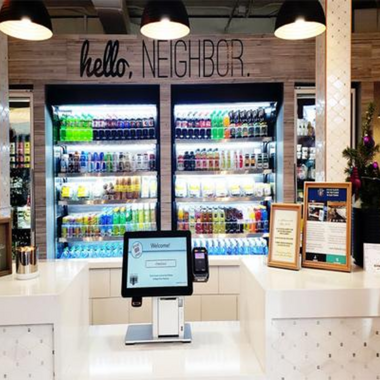
- Five minutes read
Smart strategies: a tale of two cities
We’ve published a new report which reveals that a customer-focused user experience is important for residents engaging with their Parks and Recreation services.
Have you ever waited a long time in line to book a class at your local sports facility only to find out that it’s filled up or they can only accept cash? Or perhaps you’ve been frustrated with the inconvenient opening hours to register your child for swimming lessons, or missed the registration period because you didn’t receive a notification?
Paysafe and community management platform Amilia have teamed up to investigate residents’ expectations when it comes to Parks and Recreation (P&R), and how these fit into the broader fabric of smart cities. Based on the first study of its kind conducted by Nielsen, we’ve published a new report, From Green Space to Digital Place: factoring Parks & Recreation into smart city strategies in 2018, which reveals that a customer-focused user experience is important for residents engaging with their P&R services.
Public parks, hiking trails, sports, art programs and other recreational activities offer an escape from the urban hustle and bustle. They promote an active lifestyle and a sense of community. And, according to our report, for 62% of Americans and Canadians, programmes on offer at local P&R facilities is an important factor when choosing where to live and settle down. North American cities thrive when local residents buck the 20th century trend of moving to the suburbs. The 21st century is all about staying in the downtown core and being part of an urban revival. Case in point, the recent renaissance that Detroit – America’s iconic Motor Town – is currently enjoying with investment unseen since the 1950s.
But, according to our report, many residents across North America don’t use P&R facilities as much as they would like due to digital accessibility issues and an inefficient communication system. The user experience for local residents hasn’t caught up with the likes of other service providers. If you can do anything from pre-ordering your coffee to paying a bill on your morning commute with your smartphone, then why can’t you sign up online for personal training sessions at the local gym?
Putting the Smart back into Rec
Municipal administrators are increasingly turning to technology to address operational challenges — from traffic management measures such as smart traffic lights to energy saving initiatives and even crime prevention. By contrast, P&R departments are often left out of smart city strategies and so don’t benefit from the digitalisation of operations management.
From Green Spaces to Digital Places reveals that residents often face accessibility hurdles stemming from outdated practices. These include excessive amounts of paperwork and long registration queues at inconvenient hours. To top it off, the endless queueing outside in the cold, and long telephone waits are sometimes fruitless because activities fill to capacity before residents get a chance to book their space.
Of those interviewed, 57% of Americans and 48% of Canadians said they’d use the facilities more often if they had access to an online system. This means making P&R part and parcel of their overall smart strategy is an unmissable opportunity for cities.
Bridging the gap: better PR for P&R
One of the study’s more surprising findings is the lack of awareness that exists about digital P&R facilities, despite the importance residents attribute to them. Two thirds of respondents said that there is need for online registration. Yet, 48% of Americans and 55% of Canadians didn’t know whether their city actually offered them, even in cases where they were available.
According to the study, the top barrier preventing residents from using P&R facilities is lack of information. A majority of people would like to have an online directory of activities. They’d like to be able to access more detailed information on each activity such as schedule and price. And many lament the lack of reminders and updates in the run up to registration, which is often why they miss out.
Clearly, P&R departments need to step up their outreach and become more communicative with local residents. A comprehensive smart strategy would allow P&R to offer a more universally engaging experience through channels that people are already comfortable with, such as email, SMS and push notifications.
P&R and payments: the importance of being frictionless
Of course, payments are a crucial part of the equation.
Lost In Transaction, Paysafe’s body of research into customer behaviour, found that attitudes have changed radically during the past few years. Customers are growing more and more comfortable with digital payment methods.
The average person carries less than $50 (USD) in cash in their wallets. And, 54% of Americans and 52% of Canadians think they’ll be carrying even less — if any at all — in two years’ time. More importantly, people are increasingly accustomed to pay using the method they prefer, and they feel empowered to walk out if their expectations aren’t met.
This has spilled over into the public sphere. According to From Green Space to Digital Place, an average of thirteen percent of residents (10% in Canada, 14% in U.S.) stated that the lack of their preferred payment methods being offered by their P&R facilities is preventing them from registering for activities and classes.
Consumers expect the same experience whether they’re shopping online or purchasing a municipal service. Anything less is a pain point that can ultimately dissuade them from using the service, or persuade them to use it more often.
Putting big data to work
In addition to offering residents tangible lifestyle benefits smart P&R can also boost usage and, therefore, revenue, making it easier for cities to plan for the long term.
Case in point, platforms like Amilia’s SmartRec collect invaluable data that makes it possible to evaluate which activities consistently do well and which ones are less popular. This means P&R departments can offer residents more of what they want instead of wasting valuable time, budget and resources on poorly attended activities.
What’s more, an uptick in attendance at municipal-run activities can also have wider implications on the urban fabric itself.
Regular use is often the best protection against overdevelopment, because no-one wants to build over a vibrant, popular open space. So, providing opportunities that maximise community engagement allows administrators — to paraphrase Jane Jacobs the celebrated American-Canadian writer and urban theorist — to fit plans around people instead of vice versa.
Smarten up
P&R departments are at a turning point. As much as they’re an important part of the urban fabric, they also need to evolve and get in step with the times. There’s no way around it. For a majority of residents, a simple, seamless digital offering is just as essential as the in-person experience, which, in turn, improves quality of life in the city and drives local economic growth. Or, as Jane Jacobs, would have put it: “liveliness and variety attract more liveliness…”
The smart city movement is the perfect opportunity to do this. By deploying an online solution as part of a broader smart strategy, P & R departments can widen their appeal by offering users a more relevant experience. This means that P & R departments can no longer afford to force residents to pay by cash, cheque or credit card. Instead, they need to replicate the online shopping experience as closely as possible by offering a breadth of payment options, eliminating friction and creating a seamless experience across online and offline channels.




